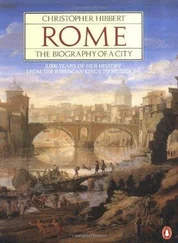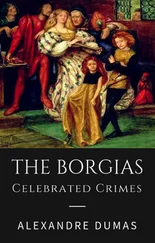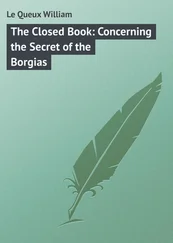On November 18 Cesare returned to Rome for a brief visit, entering the city late that afternoon through one of the smaller gates to avoid detection. He spent the next two days at the Vatican, much of the time in private discussion with his father, though he did find the opportunity to visit his beloved Lucrezia, who had given birth to a baby boy during the night of November 1. The boy had been christened Rodrigo, after his grandfather, in a splendid ceremony in St Peter’s, attended by all those cardinals who were in Rome.
Cesare left Rome again on November 21, and rode north with all possible speed, accompanied by 1,500 soldiers of the papal army, toward the northern borders of the Papal States, where his French troops — 4,000 infantry and 1,800 cavalry under the command of Yves d’Alègre — were waiting for him. He was now ready to embark on the first stage of his campaign to establish the rule of the Borgia over the Romagna in the name of the church with an attack on Imola and Forlì, two towns on the great Roman road, the Via Emilia, which were held in the name of the Riario family by Girolamo Riario’s widow, Caterina Sforza-Riario.
Alexander VI, meanwhile, dispatched the fifty-two-year-old cardinal of Monreale, the pope’s nephew and another victim of the mal francese , to Venice in order to reassure the government of that city that Venetian interests in the Romagna were not under threat, a gesture that acquired greater force when backed openly by Louis XII. The French king personally reassured the Bentivoglio family, the rulers of Bologna, that he would safeguard their state. But he made it clear that the Borgia campaign had his backing: ‘At the request of our Holy Father,’ he wrote, ‘and wishing to help him recover those lands, signories and domains [of the Papal States] and especially the castles and lands of Imola and Forlì, we have appointed our dear and well-beloved cousin, the Duke of Valence, as our lieutenant.’
With the self-confidence he now always chose to display, Cesare announced that the ‘recovery of the lands and lordships of Imola and Forlì’ would now be achieved without undue delay. The Riario family, he insisted, had become so disliked by their subjects that they could not depend upon the resistance of the inhabitants, who were more than likely to open their gates to their liberators. This confident estimate, however, did not take into account the resolution of Girolamo Riario’s widow, Caterina Sforza-Riario.
Imola proved no obstacle, and the fortress surrendered to Cesare’s armies on December 11, after a brief, almost token resistance by Caterina Sforza-Riario’s castellan, and six days later Alexander VI’s great-nephew Cardinal Juan Borgia received the oath of obedience from the civic authorities on behalf of the pope. Forlì, however, was to prove a greater obstacle; the city itself fell without a struggle but the fortress, to which Caterina had retreated, was one of the strongest in Italy. While she held out inside the castle, Cesare entered Forlì with his lance at rest in silent acknowledgement of his victory. French and Swiss mercenaries, followed by hundreds of rapacious camp followers, poured in through the gates, plundering the captured towns and violating their women.
Cesare made little effort to stem the violence: when the citizens appealed to him to curb his soldiers, he used the spurious excuse that the troops were answerable to the king of France and he could not control them. He did, however, succeed in placating the responsible citizens of both Imola and Forlì by assuring them that if he survived to keep his promise, he would make it up to them and ensure that when peace was fully restored, they would be reappointed to any offices they might have undeservedly lost.
Caterina was a remarkable woman. The illegitimate daughter of Duke Galeazzo Maria Sforza, she was now thirty-six years old. Tall and beautiful, brave and unscrupulous, she was given to outbursts of fury, real or assumed, and was ‘much feared by her men,’ who knew her among themselves as the Virago. On occasion she wore full armour, adapted to conform to her full figure, and was immediately recognized by the falcon perched on her arm. She had been married three times, had had several lovers, and had borne nine children.
After the assassination of her husband, Girolamo Riario, in 1488, she had run for shelter to the castle in Forlì, leaving her children to the mercy of his murderers, who had threatened to kill them too. She had responded in a characteristic manner, standing on the battlements of the castle, her skirt raised in her arms and shouting: ‘Fools! Can’t you see that I can make more?’
She was also alleged to be a witch with an arcane knowledge of magical potions, the recipes for which she kept in a safely guarded book and that were, in fact, potions, salves, bleaches, and all kinds of cosmetics that she used to preserve and enhance her undoubted beauty.
Her first reaction upon hearing that the pope had confiscated her state was to plan his murder. On the evening of the day that Cesare had left Rome, Burchard reported, ‘a certain Tomasino da Forlì, a musician of the Pope, and one of his colleagues were arrested and taken to Castel Sant’Angelo.’ It emerged that Tomasino had just arrived in Rome carrying letters that purported to be an offer of peace from Caterina and that he had intended, after bribing one of the Vatican guards to gain entry to the palace, to present to the pope in person.
‘If the Pope had opened them,’ continued Burchard, ‘he would have been poisoned and would have been dead a few hours or days later.’ Tomasino confessed that ‘it had been his firm belief that, once the Pope was dead, the cities of Imola and Forlì would have been liberated from the siege imposed by the Duke of Valence.’ What exactly had been in the package no one knew for sure, but it was widely rumoured that Caterina had wrapped the letters in the grave cloth of the corpse of a man who had recently died of the plague. Her nephew Cardinal Raffaello Riario fled Rome a few days later, taking with him a small group of servants and sticking to minor roads to evade any pursuers.
Despite the failure of her devious plot, the formidable Caterina still refused to give up, and she now waited in her citadel above the town at Forlì, determined to hold out as long as she could against the Borgia advance. Standing defiantly on the ramparts, she rebuffed Cesare when he came up twice to the edge of the moat to demand her surrender, and on one of these occasions, so it was reported, she almost captured him by inducing him to come onto the drawbridge to discuss the terms and then giving orders for the drawbridge to be raised.
By the last week of the year 1499, Cesare’s French troops had put their artillery in position and the attack on the castle began in earnest. Whenever the guns fell silent for a time, Caterina could be seen scrambling over fallen masonry, sometimes in armour and with her sword in hand, at others dressed as though for some grand fête, always apparently undaunted.
The outcome, however, was never in doubt. After two weeks of heavy bombardment, with Cesare’s gunners battering the citadel by night as well as by day, the keep collapsed and then a large part of the outer wall fell into the moat. A storming party crossed the moat on rafts, clambering up the tumbled stones and through the breach in the walls, pouring into the fortress to hack and stab at the defenders. On January 14 the defence collapsed, four hundred of Caterina’s soldiers were dead, and Caterina herself was taken prisoner. The slaughter was total: Burchard, who reported that news of the victory at Forlì reached Rome that night, wrote that ‘the magnificent Countess, widow of Count Girolamo Riario, has been captured; all the others have been killed.’ And the papal legate, the cardinal of Monreale, who was ill with a fever in Urbino, rashly left his sickbed to ride to Forlì to congratulate his cousin on his victory, but he only got as far as Fossombrone, where he collapsed and died.
Читать дальше











